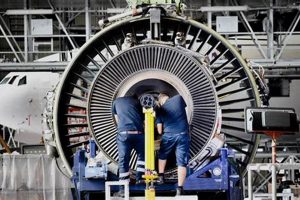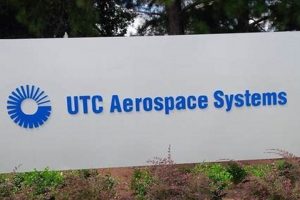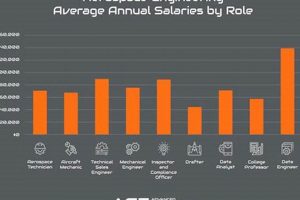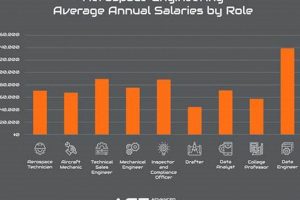Securing a first position in the field after graduation or career change requires a focused and strategic approach. This process involves understanding the core competencies sought by employers, developing a compelling presentation of skills and experiences, and navigating the recruitment landscape effectively. Successfully obtaining such a position signifies the commencement of a professional trajectory within a highly specialized and technologically advanced sector.
Gaining entry to this profession offers substantial long-term benefits, including opportunities for innovation, contribution to advancements in flight and space technology, and a financially rewarding career path. The field’s historical roots are deeply intertwined with significant scientific and technological breakthroughs, leading to continuous evolution and demand for skilled professionals. The ability to contribute to cutting-edge projects and participate in shaping the future of air and space travel remains a significant draw for aspiring engineers.
The following sections will explore key strategies, encompassing academic preparation, skill development, networking, application materials, and interview techniques, all designed to enhance prospects and ultimately land that initial, critical role. Understanding these aspects is vital for those seeking to break into this demanding yet rewarding field.
Strategies for Entering the Aerospace Engineering Profession
The following recommendations are designed to provide actionable guidance for individuals seeking their first role in the aerospace engineering sector.
Tip 1: Cultivate a Strong Academic Foundation: A Bachelor’s degree in Aerospace Engineering, or a closely related field such as Mechanical Engineering with an aerospace focus, is the fundamental requirement. A strong GPA and relevant coursework, including aerodynamics, propulsion, structures, and control systems, demonstrate competence.
Tip 2: Gain Practical Experience Through Internships: Internships at aerospace companies, government agencies (e.g., NASA), or research institutions provide invaluable hands-on experience. These experiences allow for the application of theoretical knowledge to real-world problems and demonstrate a proactive approach to professional development.
Tip 3: Develop Proficiency in Relevant Software: Familiarity with industry-standard software such as MATLAB, Simulink, ANSYS, CATIA, and SolidWorks is highly desirable. These tools are used for modeling, simulation, and design, and competence in their use significantly enhances employability.
Tip 4: Highlight Relevant Projects on Resume: Showcase academic or personal projects that demonstrate engineering skills and problem-solving abilities. Examples include designing and building model aircraft, participating in rocketry competitions, or conducting research related to aerospace topics. Quantifiable results, such as performance metrics or efficiency improvements, should be emphasized.
Tip 5: Network Actively Within the Industry: Attend industry conferences, career fairs, and university events to connect with professionals in the field. Networking provides opportunities to learn about potential job openings, gain insights into company culture, and establish valuable contacts.
Tip 6: Tailor Resume and Cover Letter to Specific Roles: Generic applications are often overlooked. Thoroughly research the company and specific job requirements and tailor the resume and cover letter to highlight relevant skills and experiences. Emphasis should be placed on demonstrating a clear understanding of the role’s responsibilities and how the applicant’s qualifications align with the company’s needs.
Tip 7: Prepare Thoroughly for Technical Interviews: Aerospace engineering interviews often involve technical questions assessing understanding of fundamental concepts and problem-solving abilities. Practice answering common interview questions, reviewing core engineering principles, and preparing to discuss relevant projects in detail.
Adhering to these recommendations significantly increases the likelihood of securing a sought-after initial position in the aerospace engineering field. Combining strong academic credentials with practical experience, technical skills, and effective networking is the optimal pathway to success.
The subsequent sections will delve into additional resources and strategies for navigating the job search process and maximizing opportunities for advancement within the aerospace sector.
1. Academic Excellence
Academic excellence forms a foundational pillar in the pursuit of initial employment within the aerospace engineering sector. A strong academic record, characterized by a high Grade Point Average (GPA) and rigorous coursework, serves as an initial filter for employers. It signifies a candidate’s aptitude for complex problem-solving, analytical thinking, and the ability to master challenging technical concepts inherent in aerospace engineering. Failure to demonstrate a solid academic foundation can immediately disqualify an applicant, regardless of other potentially valuable attributes.
The connection between academic performance and professional success is not merely correlational; it is causal. Mastery of fundamental engineering principles, as demonstrated through coursework in areas such as aerodynamics, propulsion, structures, and control systems, directly translates into an engineer’s ability to contribute meaningfully to design, analysis, and testing tasks. For instance, a graduate with a deep understanding of fluid dynamics, evidenced by high grades in related courses, is better equipped to contribute to aerodynamic design projects. Moreover, involvement in academically rigorous projects, such as designing and building model aircraft or participating in engineering competitions, further reinforces theoretical knowledge and showcases practical application skills. These experiences serve as concrete examples of a candidate’s capabilities and enhance their appeal to potential employers.
While academic excellence alone does not guarantee a job offer, it provides a crucial competitive advantage. It establishes a baseline level of competence and demonstrates a commitment to learning and professional development. Combining strong academic credentials with practical experience, as gained through internships and personal projects, and effective communication skills creates a well-rounded profile that significantly increases the likelihood of securing an entry-level aerospace engineering position. Overcoming potential limitations in other areas can be partially mitigated by an exceptionally strong academic background, illustrating its pivotal role in initiating a successful career.
2. Relevant Internships
Acquiring pertinent internship experience serves as a critical differentiator for candidates seeking initial employment in aerospace engineering. Such internships offer opportunities to apply theoretical knowledge to practical situations, thereby bridging the gap between academic learning and professional expectations.
- Practical Skill Development
Internships provide hands-on experience in areas such as design, analysis, testing, and manufacturing. These activities foster the development of practical skills directly applicable to job functions. For example, an internship focused on computational fluid dynamics could involve running simulations, analyzing results, and optimizing designs, tasks commonly encountered in entry-level positions. Demonstrating such practical skills significantly enhances an applicant’s marketability.
- Industry Exposure and Networking
Internships offer valuable exposure to the aerospace industry’s culture, workflows, and professional standards. They provide opportunities to interact with experienced engineers and build a professional network. Contacts made during an internship can serve as references, mentors, or potential future colleagues. Attendance at industry events and participation in company projects broaden understanding and connections within the field.
- Enhanced Resume Credibility
Listing relevant internships on a resume immediately elevates a candidate’s profile. Employers view internship experience as evidence of initiative, commitment, and a proactive approach to professional development. Internships at well-regarded companies or government agencies, such as Boeing, Lockheed Martin, or NASA, carry significant weight. Specific details about projects, responsibilities, and accomplishments during the internship should be clearly articulated to showcase quantifiable achievements.
- Increased Job Offer Likelihood
Candidates with relevant internship experience are demonstrably more likely to receive job offers. Internship experiences provide a trial period for both the intern and the company. A successful internship often leads to a full-time job offer upon graduation. Even if a job offer is not immediately extended, the experience gained through the internship significantly strengthens the candidate’s overall qualifications, improving their prospects in the broader job market.
In summary, relevant internships provide tangible benefits that significantly contribute to securing initial employment in aerospace engineering. The practical skills acquired, industry exposure gained, resume credibility enhanced, and increased likelihood of job offers collectively illustrate the pivotal role of internships in facilitating the transition from academia to a professional aerospace career.
3. Technical Proficiency
In the context of securing an initial position in aerospace engineering, technical proficiency represents a critical determinant of candidate success. Demonstrable competence in industry-standard software, analytical techniques, and engineering principles forms a cornerstone of a competitive application.
- Software Proficiency
Proficiency with industry-standard software packages is essential. Programs such as MATLAB for numerical computation, ANSYS for finite element analysis, and CATIA or SolidWorks for CAD modeling are frequently used in aerospace engineering design and analysis. A candidate’s ability to utilize these tools effectively directly impacts their ability to contribute to project teams and perform necessary tasks. Demonstrating familiarity with these programs through coursework, projects, or internships is a significant advantage.
- Analytical Skills
Aerospace engineering inherently relies on strong analytical skills. The ability to apply mathematical and scientific principles to solve complex problems is paramount. This includes skills in areas such as stress analysis, fluid dynamics, and control systems design. Candidates must be able to interpret data, identify trends, and draw conclusions based on sound engineering judgment. Analytical skills are typically assessed through technical interviews, problem-solving exercises, and the evaluation of academic projects.
- Practical Application of Engineering Principles
A strong understanding of fundamental engineering principles is necessary but not sufficient. Candidates must also demonstrate the ability to apply these principles to real-world problems. This includes the ability to design components, analyze systems, and optimize performance. Hands-on experience through internships, research projects, or personal projects is invaluable in developing this competency. Projects that involve designing and building physical prototypes are particularly impactful, showcasing both theoretical knowledge and practical skills.
- Knowledge of Aerospace Materials and Manufacturing Processes
A foundational understanding of the materials used in aerospace applications, such as aluminum alloys, composites, and titanium, is crucial. Understanding the properties of these materials, their limitations, and appropriate applications directly impacts design decisions. Additionally, familiarity with manufacturing processes specific to the aerospace industry, such as machining, welding, and composite fabrication, is highly beneficial. This knowledge enables engineers to design parts that are both structurally sound and manufacturable, contributing to overall project efficiency and success.
The acquisition and demonstration of these facets of technical proficiency directly enhance a candidate’s competitiveness in the aerospace engineering job market. Proficiency enables immediate contributions to project teams and signifies a solid foundation for continued professional growth. Investments in skill development, software training, and hands-on experience are crucial steps in securing an entry-level position and establishing a successful career in the field.
4. Targeted Application
The concept of a targeted application is paramount in the pursuit of an entry-level aerospace engineering position. A generic approach to job applications often yields limited success in this competitive field. A targeted application, conversely, demonstrates a candidate’s understanding of the specific role and the organization’s needs, thereby increasing the likelihood of securing an interview and, ultimately, a job offer.
- Customized Resume and Cover Letter
A tailored resume and cover letter directly address the specific requirements outlined in the job description. Generic templates fail to highlight the most relevant skills and experiences. A targeted approach involves carefully reviewing the job posting and adjusting the resume to emphasize qualifications that align with the employer’s priorities. The cover letter should articulate a clear understanding of the company’s mission and values, and explain how the applicant’s skills and experiences can contribute to its success. For example, if a job posting emphasizes experience with composite materials, the resume should highlight relevant projects or coursework in that area.
- Highlighting Relevant Skills and Experience
A targeted application focuses on showcasing skills and experiences that are directly relevant to the specific role. A comprehensive list of skills is less effective than a carefully curated selection that demonstrates a clear match with the job requirements. Quantifiable achievements, such as contributions to successful projects or improvements in efficiency, should be emphasized to demonstrate the applicant’s potential impact. If the position requires experience with a particular software package, proficiency in that software should be prominently displayed. Avoiding irrelevant information strengthens the overall impression of a well-qualified candidate.
- Demonstrating Knowledge of the Company
A targeted application reveals a thorough understanding of the company’s products, services, and mission. This demonstrates genuine interest and a proactive approach to research. This may involve researching the company’s recent projects, financial performance, or technological innovations. Demonstrating this knowledge in the cover letter or during an interview can differentiate an applicant from other candidates. Understanding the company’s challenges and opportunities allows the applicant to articulate how their skills and experience can contribute to the company’s future success.
- Networking and Personal Connections
Leveraging personal connections and networking opportunities can significantly enhance the impact of a targeted application. Identifying individuals within the company who can provide insights into the role and the organization’s culture offers a distinct advantage. A referral from a current employee can significantly increase the chances of an application being considered. Informational interviews can provide valuable insights into the company’s needs and expectations, allowing the applicant to tailor their application more effectively. Building a professional network through industry events, conferences, and online platforms can also lead to job opportunities that are not publicly advertised.
In conclusion, a targeted application strategy is not merely about submitting a resume; it is about presenting a compelling case for why the applicant is the ideal candidate for the specific role within the specific company. By tailoring the application to highlight relevant skills, demonstrating knowledge of the company, and leveraging networking opportunities, candidates can significantly increase their chances of securing an entry-level aerospace engineering position. The effort invested in a targeted application reflects a commitment to the role and a genuine interest in contributing to the company’s success.
5. Effective Networking
Effective networking plays a crucial role in facilitating entry into the aerospace engineering profession. The process of establishing and nurturing professional relationships significantly enhances visibility, provides access to unadvertised opportunities, and offers valuable insights into the industry landscape.
- Informational Interviews
Requesting informational interviews with aerospace professionals provides invaluable insights into specific roles, company cultures, and industry trends. This proactive approach demonstrates initiative and allows aspiring engineers to gain a realistic understanding of the day-to-day realities of the profession. Such interviews may uncover unadvertised job openings or lead to referrals, significantly increasing the applicant’s chances of securing a position. For instance, a conversation with a design engineer at a leading aerospace manufacturer can provide specific details about the skills and experiences most valued by the company, allowing applicants to tailor their resumes and cover letters accordingly.
- Industry Events and Conferences
Attending industry events, such as conferences and trade shows, provides opportunities to connect with engineers, recruiters, and company representatives. These events often feature presentations, workshops, and networking sessions that allow attendees to learn about the latest technological advancements and career opportunities. Active participation in these events, including asking informed questions during presentations and engaging in conversations with professionals, demonstrates a genuine interest in the field and increases visibility to potential employers. For example, participating in the American Institute of Aeronautics and Astronautics (AIAA) SciTech Forum or similar events allows for direct interaction with professionals and exposure to cutting-edge research.
- Online Professional Platforms
Utilizing online professional platforms, such as LinkedIn, is essential for building and maintaining a professional network. Creating a comprehensive profile that highlights skills, experiences, and accomplishments is crucial for attracting the attention of recruiters and industry professionals. Actively participating in relevant online groups, engaging in discussions, and sharing relevant content enhances visibility and establishes credibility. Connecting with engineers and recruiters at target companies can lead to valuable conversations and potential job opportunities. Regularly updating the profile to reflect new skills and experiences ensures that the information remains current and relevant.
- University Alumni Networks
Leveraging university alumni networks provides a valuable source of connections and support. Alumni often have a strong interest in helping recent graduates succeed and can offer valuable career advice, mentorship, and referrals. Attending alumni events and reaching out to alumni working in the aerospace industry can lead to valuable networking opportunities. Informational interviews with alumni can provide insights into specific companies and roles, as well as advice on navigating the job search process. Actively participating in alumni networks fosters a sense of community and provides access to a supportive network of professionals.
The facets described above underscore that strategic networking efforts can significantly impact the probability of securing an entry-level position in the aerospace field. These connections provide direct routes to job opportunities that may remain inaccessible through conventional application processes. Nurturing these relationships can have a profound and lasting impact on career progression.
Frequently Asked Questions
The following section addresses common inquiries and clarifies aspects related to gaining initial employment within the aerospace engineering field.
Question 1: Is a graduate degree necessary to obtain an entry-level aerospace engineering position?
While a graduate degree can enhance career prospects, it is generally not a strict requirement for initial employment. A Bachelor’s degree in Aerospace Engineering, or a closely related field, coupled with relevant internship experience and a strong academic record is typically sufficient for entry-level positions. However, specialized roles or research-oriented positions may favor candidates with advanced degrees.
Question 2: What types of internship experiences are considered most valuable by employers?
Internships at reputable aerospace companies, government agencies (e.g., NASA), or research institutions are highly valued. Internships that provide hands-on experience in design, analysis, testing, or manufacturing are particularly beneficial. The specific projects and responsibilities undertaken during the internship, and the quantifiable results achieved, are crucial factors in demonstrating the value of the experience.
Question 3: Which software packages are essential for aspiring aerospace engineers to master?
Proficiency in industry-standard software such as MATLAB, Simulink, ANSYS, CATIA, and SolidWorks is highly advantageous. These tools are used for modeling, simulation, and design, and competence in their use significantly enhances employability. Specific software requirements may vary depending on the role and the company.
Question 4: How important is networking in securing an entry-level position?
Networking plays a critical role. Attending industry conferences, career fairs, and university events provides opportunities to connect with professionals in the field, learn about potential job openings, and gain insights into company culture. Building and maintaining a professional network can lead to valuable referrals and unadvertised job opportunities.
Question 5: What should be included in a strong aerospace engineering resume?
A strong aerospace engineering resume should highlight relevant academic achievements, internship experiences, technical skills, and project accomplishments. The resume should be tailored to the specific job requirements and should emphasize quantifiable results. A clear and concise presentation of information is essential.
Question 6: What are typical questions asked during an aerospace engineering interview?
Aerospace engineering interviews often involve technical questions assessing understanding of fundamental concepts and problem-solving abilities. Questions may cover areas such as aerodynamics, propulsion, structures, control systems, and materials. Behavioral questions designed to assess teamwork, communication skills, and problem-solving approaches are also common. Preparation by reviewing core engineering principles and practicing answering common interview questions is essential.
Mastery of the elements outlined above enhances prospects for achieving coveted initial employment opportunities within the aerospace engineering sector.
The upcoming segment examines additional resources and strategies to efficiently manage the employment-seeking trajectory and amplify chances within the aerospace domain.
Achieving Initial Employment in Aerospace Engineering
The preceding discussion has explored the multifaceted approach required to secure an initial position. Emphasis has been placed on academic preparation, the acquisition of practical experience through internships, the development of technical proficiency, the strategic tailoring of application materials, and the cultivation of an effective professional network. Mastery of these elements is paramount for aspiring engineers seeking to enter this competitive field.
A sustained commitment to professional development, combined with a proactive approach to the job search process, will significantly enhance the prospects of achieving a successful and rewarding career in aerospace engineering. Continued learning and adaptation will be crucial for navigating the ever-evolving technological landscape of this dynamic industry.







